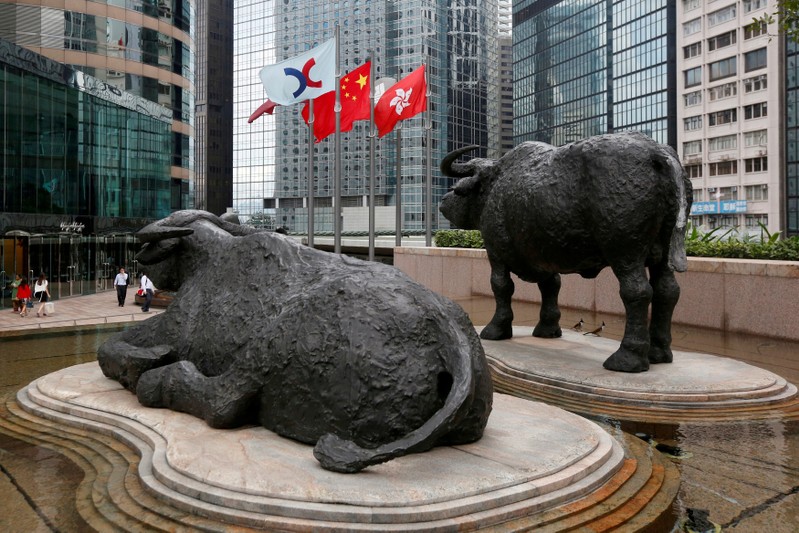
FILE PHOTO: The Hong Kong Exchanges flag, Chinese national flag and Hong Kong flag are hoisted outside the Hong Kong Stocks Exchange in Hong Kong June 7, 2016. REUTERS/Bobby Yip/File Photo
February 5, 2018
By Wayne Cole
SYDNEY (Reuters) – Asian shares fell the most in over a year on Monday as fears of resurgent inflation battered bonds, toppled Wall Street from record highs and sparked speculation that central banks globally might be forced to tighten policy more aggressively.
MSCI’s broadest index of Asia-Pacific shares outside Japan <.MIAPJ0000PUS> shed 1.7 percent in the largest daily drop since late 2016.
E-Mini futures for the S&P 500 <ESc1> fell another 0.3 percent, an unusually sharp move for Asian hours and suggesting further losses in U.S. markets later in the session.
Dow futures <1YMc1> slipped 0.6 percent while FTSE futures <FFIc1> lost 1 percent.
Asian markets was covered in a sea of red, with every single bourse stumbling. Japan’s Nikkei <.N225> sank 2.6 percent, while Australia’s main index <.AXJO> lost 1.6 percent and Chinese blue chips <.CSI300> slid 0.7 percent.
Investors were spooked by Friday’s U.S. payrolls report which showed wages growing at their fastest pace in more than 8-1/2 years and fuelling inflation expectations <USIL5YF5Y=R>.
Futures markets <0#FF:> reacted by pricing in the risk of three, or even more, interest rate rises from the Federal Reserve this year.
“The earnings data fits too closely with the narrative of emerging wage pressures to be dismissed,” said Deutsche Bank macro strategist Alan Ruskin.
“The data will add fuel to the debate on whether the Fed is falling behind the curve. It will raise the chances of the Fed median dots shifting up to four rate hikes for 2018,” he added.
That would be negative for emerging markets and commodity currencies, said Ruskin. Both the Australian and New Zealand dollars fell sharply in the wake of the job numbers, along with a range of Asian currencies.
It was also a major blow to government bonds. Yields on 10-year U.S. Treasury paper <US10YT=RR> were up at a four-year peak of 2.86 percent, having jumped almost 7 basis points on Friday.
The 2-year yield <US2YT=RR> was near a nine-year top at 2.162 percent, tightening financial conditions and offering a more competitive return compared to equities. The dividend return of the Dow, for instance, was 2.13 percent.
PRICED FOR PERFECTION
Wall Street had already been flashing expensive by many historical measures and sold off in reaction.
“It has to be remembered that U.S. shares were priced for perfection at around 19 times earnings,” said Craig James, chief economist at fund manager CommSec, noting the historic average is around 15 times.
“Still, U.S. companies have produced stellar earnings over the reporting period. So it is understandable that some ‘irrational exuberance’ would emerge.”
With half of the S&P 500 companies having reported, 78 percent have beaten expectations against an average 64 percent.
Chris Weston, chief market strategist at broker IG, noted the sudden spike in volatility caused some rules-based funds to automatically dump stock as their models required.
“There is talk that volatility targeting annuity funds could have to sell a further $30 billion of stock this week and another $40 billion should realized volatility not retreat lower,” he warned.
The lift in U.S. yields provided some initial support to the dollar after a rocky start to the year, though it was starting to lose altitude again in Asian trade.
Against a basket of currencies, the dollar was down a fraction at 89.154 <.DXY> having climbed 0.6 percent on Friday for its biggest single day gain in three months.
The dollar backed off to 109.95 yen <JPY=> from an early 110.29, while the euro was barely changed at $1.2457 <EUR=>.
Any rally in the U.S. dollar is considered a negative for commodities priced in the currency, with the Thomson Reuters CRB index <.TRCCRB> down 0.5 percent. Gold <XAU=> was off a touch at $1,330.47 an ounce after losing 1 percent on Friday.
In oil markets, U.S. crude <CLc1> fell 66 cents to $64.79 a barrel, while Brent <LCOc1> lost 71 cents to $67.87.
(Reporting by Wayne Cole and Swati Pandey; Editing by Kim Coghill and Eric Meijer)
